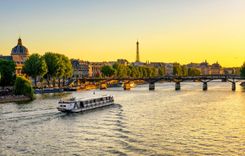5. Mont Ventoux
The fields around Mont Ventoux feel different—there's this contrast between the purple slopes and the mountain’s pale limestone peak that’s pretty striking. Lavender grows especially well here because of the altitude and climate, and the oil tends to be stronger in scent.
Early July is usually when the flowers are at their best. Farmers in this area still use traditional growing methods, which helps keep local plants and bee populations thriving.
Sault is the closest village, and it runs a lavender festival in summer with things like harvesting competitions and oil distillation demos. Local nougat made with lavender is widely available, and from mid-summer, black truffles are another regional specialty. A fantastic addition to any southern France itinerary.
How to get to Mont Ventoux
Sault is about an hour’s drive east of Avignon. In summer, buses run between the two, but if you want to stop at the fields or travel at your own pace, driving is better. The Route de la Lavande is clearly marked with signs. If you're going for photos, try to get there early in the morning or around sunset—the light’s better and it’s less busy.
6. Simiane-la-Rotonde
Simiane-la-Rotonde has a dramatic hillside layout with lavender fields arranged almost in rings around the village. Because it sits at over 1,600 feet (500 meters), the lavender blooms a bit later—usually late July.
Inside the Sainte-Marie Abbey, there's a working aromatherapy lab where you can actually make your own oil blends. The rotunda that gives the village its name is from the 12th century, and if you climb up to the terrace, the views stretch across the whole valley.
The village is known for its few pottery studios, where you’re likely to find some lavender-themed pieces in their collections. These are fantastic souvenirs.
How to get to Simiane-la-Rotonde
It’s easiest to drive—the village is around 1.5 hours northeast of Aix-en-Provence. Head toward Banon, which is also known for its goat cheese, then keep going until you reach Simiane.
The roads are narrow and a bit winding, so it’s not the kind of drive you want to rush. If you’re not comfortable mountain driving, there are tours that leave from Forcalquier and take care of the transport. For more on transit through the country, see our guide to getting around France.













